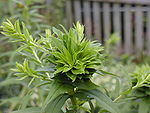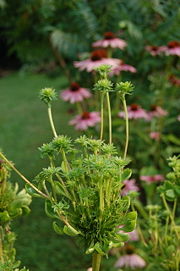
Phyllody
Encyclopedia
Phyllody is the development of floral parts into leafy structures, generally caused by virus
or phytoplasma
infection such as aster yellows
. Evidence suggests that the phytoplasma downregulates a gene involved in petal formation, instead causing leaves or leaflike structures to form. Phyllody causes the affected plant to become partially or entirely sterile, as it is unable to normally produce flowers. This can also happen in some cultivars of roses apparently without infection.


Virus
A virus is a small infectious agent that can replicate only inside the living cells of organisms. Viruses infect all types of organisms, from animals and plants to bacteria and archaea...
or phytoplasma
Phytoplasma
Phytoplasma are specialised bacteria that are obligate parasites of plant phloem tissue and transmitting insects . They were first discovered by scientists in 1967 and were named mycoplasma-like organisms or MLOs. They cannot be cultured in vitro in cell-free media...
infection such as aster yellows
Aster yellows
Aster yellows is a chronic, systemic plant disease caused by a bacterium-like organism called a phytoplasma. The aster yellows phytoplasma affects 300 species in 38 families of broad-leaf herbaceous plants, primarily in the aster family. Symptoms are variable and can include phyllody, virescence,...
. Evidence suggests that the phytoplasma downregulates a gene involved in petal formation, instead causing leaves or leaflike structures to form. Phyllody causes the affected plant to become partially or entirely sterile, as it is unable to normally produce flowers. This can also happen in some cultivars of roses apparently without infection.



